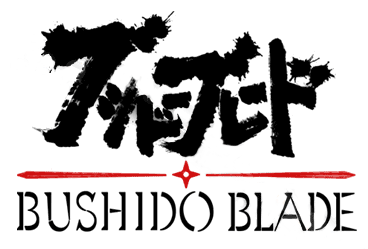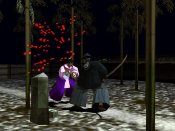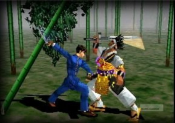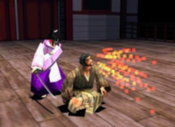
Friday is now upon us and you know what that means -- it’s time for another fun filled installment of Missing in Action!
For all of those neophytes out there, let me explain how MIA works. MIA is a bi-weekly column where I pick out a game or franchise of old, dust it off and present it for a possible current generation entry.
To qualify for the MIA treatment the game or franchise cannot have appeared on any of the current generation consoles, nor can a new title be currently in development, though unconfirmed rumors, speculation and hearsay are certainly permissible. Also the title or franchise must be well served by a current generation entry. E.T. for Atari is not likely to grace these electronic pages.
In this installment we present, for your consideration, Bushido Blade!

Bushido Blade came out in 1997 as an exclusive for the original Playstation. It was a critical darling and a sequel was released the following year to similar accolades. Even though the series was considered a success both in terms of sales and critical acclaim, Squaresoft has not yet released another entry in the series. This is primarily due to disagreements between Squaresoft and the developer of the game, Light Weight. Light Weight would later use the Bushido Blade engine to power their Kengo series. While Kengo was considered the spiritual successor to Bushido Blade, it lacked the polish and depth of the original series and was lambasted by critics, resulting in a Metacritic rating of 38.
For the purposes of MIA, we’ll be looking at Bushido Blade as a franchise independent of Kengo, since there is no formal connection between the titles. Squaresoft still owns the Bushido Blade property and could develop a new game internally or with a new third party developer.
Bushido Blade was released at a time when the fighting genre was on the decline. It managed to do well for two reasons:
1) It was a completely unique experience in the otherwise dull fighting genre, and…
2) A demo for the game was released on the same disc that had a demo for a little title called Final Fantasy VII
Since the second point is irrelevant to the quality of the game, let’s delve into the first reason and what made it so unique.
One and Done
 For those unfamiliar with the series, Bushido Blade pits two sword bearingwielding fighters against each other. The fights were often slow, with slices and blocks deliberately timed. A well aimed blow could cripple your enemy by breaking an arm or a leg. Strike true, and the fight could be over with a single blowhit.
For those unfamiliar with the series, Bushido Blade pits two sword bearingwielding fighters against each other. The fights were often slow, with slices and blocks deliberately timed. A well aimed blow could cripple your enemy by breaking an arm or a leg. Strike true, and the fight could be over with a single blowhit.
This approach to the sword duel contrasted greatly with fighters of the time like Tekken and Virtua Fighter. Matches could be over in a matter of seconds or stretch on for minutes on end. The result was a game with a unique, yet enjoyable level of tension. Masters of the game would bide their time and watch carefully for openings to end the match. Newcomers would have just as much of a chance to land a lucky blow and upset the competition.
This style of play could be transferred to the current generation largely unchanged. With more disc space for content, the roster of characters and weapons could be expanded to add some variety to the mix. We could also add a robust training mode that would teach players the power of patience and timing.
To Higher Ground
 Another one of Bushido Blade’s unique attributes was the stages. Most fighting games have set stages in a small, fixed area. Games like Dead or Alive may have multi-tiered stages that will bring the fight from one enclosed space to another, but fighting games are largely restrictive in their fighting space.
Another one of Bushido Blade’s unique attributes was the stages. Most fighting games have set stages in a small, fixed area. Games like Dead or Alive may have multi-tiered stages that will bring the fight from one enclosed space to another, but fighting games are largely restrictive in their fighting space.
Bushido Blade was played on a three -dimensional plane that allowed the user to move around their opponents. While this in itself is not remarkable, it became quite interesting when combined with expansive and sprawling stages that featured interactive environments that could be used to turn the tide of battle. Don’t like your odds on the current playing field? Retreat to a bamboo forest, where the environment could potentially hamper the swing of your opponent’s blade.
These stages were huge with multiple levels and a myriad of conditions present. The different locations will change how you decide to play. On a current generation platform, these could be expanded and the differences between elevations could become more subtle. They say whoever has the high ground has the advantage and this could be a part of, adding even more layers of strategic combat between two players.
Break a Leg
 As mentioned before, a well timed swing of the sword could result in the shattering of your opponent’s leg or arm. Considering that we are wielding extremely sharp tools of death, this could be expanded upon to add further depth and strategy.
As mentioned before, a well timed swing of the sword could result in the shattering of your opponent’s leg or arm. Considering that we are wielding extremely sharp tools of death, this could be expanded upon to add further depth and strategy.
Consider this – in Bushido Blade the characters don’t have life bars. They are unnecessary since it only takes one critical hit to end the battle. While I don’t want a life bar, I’d be interested in adding a blood level meter.
Each character would start off the match with a full blood meter. The meter would remain full until a character is the recipient of a particularly deep slice, resulting in a bleeding wound. At this point, the blood meter would slowly start slowly draining. When the blood meter runs out, the character would pass out due to lack of blood.
This would add an additional level or realism to accompany the broken bones, but would also instill a level of urgency in a player that has been well struck, but not killed, making battles more interesting. You could even add elements to the single player or online matches, by blurring the screen more and more as the meter nears depletion. Imagine the triumph one would feel after winning a match just before collapsing from massive hemorrhaging.
It is very simple to see how Bushido Blade would fit well into today’s video game landscape. With a nice polish on the game mechanics, updated graphics, a robust online challenge system and some additions as noted above, this game could slice its way deep into our electronic hearts.
Anything else that would add to the Bushido Blade experience on the current generation? Have any war stories from the original release? Add to the discussion by sounding off in the comments section below!









Comments